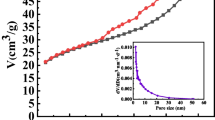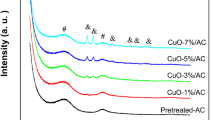Abstract
Semi-coking wastewater contains a rich source of toxic and refractory compounds. Three-dimensional electro-Fenton (3D/EF) process used CuFe2O4 as heterocatalyst and activated carbon (AC) as particle electrode was constructed for degrading semi-coking wastewater greenly and efficiently. CuFe2O4 nanoparticles were prepared by coprecipitation method and characterized by X-ray diffraction (XRD), scanning electron microscopy (SEM), and energy disperse spectroscopy (EDS). Factors like dosage of CuFe2O4, applied voltage, dosage of AC and pH, which effect COD removal rate of semi-coking waste water were studied. The results showed that COD removal rate reached to 80.9% by 3D/EF process at the optimum condition: 4 V, 0.3 g of CuFe2O4, 1 g of AC and pH = 3. Trapping experiment suggesting that hydroxyl radical (•OH) is the main active radical. The surface composition and chemical states of the fresh and used CuFe2O4 were analyzed by XPS indicating that Fe, Cu, and O species are involved into the 3D/EF process. Additionally, anode oxidation and the adsorption and catalysis of AC are also contributed to the bleaching of semi-coking waste water. The possible mechanisms of 3D/EF for degrading semi-coking waste water by CuFe2O4 heterocatalyst were proposed.











Similar content being viewed by others
Data availability
Not applicable.
References
Can W, Yao-Kun H, Qing Z et al (2014) Treatment of secondary effluent using a three-dimensional electrode system: COD removal, biotoxicity assessment, and disinfection effects. Chem Eng J 243:1–6
Chen Z, Wang L, Xu H et al (2020) Efficient heterogeneous activation of peroxymonosulfate by modified CuFe2O4 for degradation of tetrabromobisphenol A. Chem Eng J 389:124345
Dargahi A, Hasani K, Mokhtari SA et al (2021) Highly effective degradation of 2,4-Dichlorophenoxyacetic acid herbicide in a three-dimensional sono-electro-Fenton (3D/SEF) system using powder activated carbon (PAC)/Fe3O4 as magnetic particle electrode. J Environ Chem Eng 9(5):105889
Ding R, Li W, He C et al (2021) Oxygen vacancy on hollow sphere CuFe2O4 as an efficient Fenton-like catalysis for organic pollutant degradation over a wide pH range. Appl Catal B 291:120069
Du X, Zhang R, Gan Z et al (2013) Treatment of high strength coking wastewater by supercritical water oxidation. Fuel 104:77–82
Ferreira LS, Silva TR, Silva VD et al (2020) Proteic sol-gel synthesis, structure and battery-type behavior of Fe-based spinels (MFe2O4, M = Cu Co, Ni). Adv Powder Technol 31(2):604–613
Gao J, Wu S, Han Y et al (2018) 3D mesoporous CuFe2O4 as a catalyst for photo-Fenton removal of sulfonamide antibiotics at near neutral pH. J Colloid Interface Sci 524:409–416
Garrido-Ramírez EG, Marco JF, Escalona N et al (2016) Preparation and characterization of bimetallic Fe–Cu allophane nanoclays and their activity in the phenol oxidation by heterogeneous electro-Fenton reaction. Microporous Mesoporous Mater 225:303–311
GilPavas E, Dobrosz-Gómez I, Gómez-García M (2019) Optimization and toxicity assessment of a combined electrocoagulation, H2O2/Fe2+/UV and activated carbon adsorption for textile wastewater treatment. The Science of the Total Environment 651:551–560
Guo D, Shi Q, He B et al (2011) Different solvents for the regeneration of the exhausted activated carbon used in the treatment of coking wastewater. J Hazard Mater 186(2–3):1788–1793
Hou B, Han H, Zhuang H et al (2015) A novel integration of three-dimensional electro-Fenton and biological activated carbon and its application in the advanced treatment of biologically pretreated Lurgi coal gasification wastewater. Biores Technol 196:721–725
Hou B, Han H, Jia S et al (2016) Three-dimensional heterogeneous electro-Fenton oxidation of biologically pretreated coal gasification wastewater using sludge derived carbon as catalytic particle electrodes and catalyst. J Taiwan Inst Chem Eng 60:352–360
Huang Z, Gao N, Lin Y et al (2022) Exploring the migration and transformation of lattice oxygen during chemical looping with NiFe2O4 oxygen carrier. Chem Eng J 429:132064
Li Y, Gu G, Zhao J et al (2003) Treatment of coke-plant wastewater by biofilm systems for removal of organic compounds and nitrogen. Chemosphere 52(6):997–1005
Li R, Jin X, Megharaj M et al (2015) Heterogeneous Fenton oxidation of 2,4-dichlorophenol using iron-based nanoparticles and persulfate system. Chem Eng J 264:587–594
Li Z, Guo C, Lyu J et al (2019) Tetracycline degradation by persulfate activated with magnetic Cu/CuFe2O4 composite: efficiency, stability, mechanism and degradation pathway. J Hazard Mater 373:85–96
Li J, Wang S, Li Y et al (2020) Supercritical water oxidation of semi-coke wastewater: effects of operating parameters, reaction mechanism and process enhancement. Sci Total Environ 710:134396
Li M, Qin X, Cui J et al (2021a) Three-dimensional Electro-Fenton degradation for fulvic acids with Cu-Fe bimetallic aerogel-like carbon as particle electrode and catalyst: electrode preparation, operation parameter optimization and mechanism. J Environ Chem Eng 9(4):105573
Li N, Xia Y, He X et al (2021b) Glucose addition enhanced the advanced treatment of coking wastewater. Water 13(23):3365
Liu Y, Liu J, Zhang A et al (2017) Treatment effects and genotoxicity relevance of the toxic organic pollutants in semi-coking wastewater by combined treatment process. Environ Pollut 220:13–19
Liu D, Wang C, Song Y et al (2019) Effective mineralization of quinoline and bio-treated coking wastewater by catalytic ozonation using CuFe2O4/Sepiolite catalyst: Efficiency and mechanism. Chemosphere 227:647–656
Ma X, Wang X, Liu Y et al (2017) Variations in toxicity of semi-coking wastewater treatment processes and their toxicity prediction. Ecotoxicol Environ Saf 138:163–169
Mdletshe LS, Makgwane PR, Ray SS (2019) Fabrication of bimetal CuFe2O4 oxide redox-active nanocatalyst for oxidation of pinene to renewable aroma oxygenates. Nanomaterials 9(8):1140
Navalon S, Dhakshinamoorthy, Alvaro M et al (2011) Heterogeneous Fenton catalysts based on activated carbon and related materials. Chemsuschem 4(12):1712–1730
Padmapriya G, Manikandan A, Krishnasamy V et al (2016) Spinel NixZn1−xFe2O4 (0.0 ≤ x ≤ 1.0) nano-photocatalysts: synthesis, characterization and photocatalytic degradation of methylene blue dye. J Mol Struct 1119:39–47
Palanivel B, Hu C, Shkir M et al (2021) Fluorine doped g-C3N4 coupled NiFe2O4 heterojunction: consumption of H2O2 for production of hydroxyl radicals towards paracetamol degradation. Colloid and Interface Science Communications 42:100410
Pan G, Sun Z (2021) Cu-doped g-C3N4 catalyst with stable Cu0 and Cu+ for enhanced amoxicillin degradation by heterogeneous electro-Fenton process at neutral pH. Chemosphere 283:131257–131257
Qi F, Chu W, Xu B (2016) Comparison of phenacetin degradation in aqueous solutions by catalytic ozonation with CuFe2O4 and its precursor: surface properties, intermediates and reaction mechanisms. Chem Eng J 284:28–36
Ren Y, Li T, Wei C (2013) Competitive adsorption between phenol, aniline and n-Heptane in tailrace coking wastewater. Water Air Soil Pollut 224(1):1–11
Roonasi P, Nezhad AY (2016) A comparative study of a series of ferrite nanoparticles as heterogeneous catalysts for phenol removal at neutral pH. Mater Chem Phys 172:143–149
Silva E, Brasileiro I, Madeira V et al (2020) Reusable CuFe2O4–Fe2O3 catalyst synthesis and application for the heterogeneous photo-Fenton degradation of methylene blue in visible light. J Environ Chem Eng 8(5):104132
Tan C, Gao N, Fu D et al (2017) Efficient degradation of paracetamol with nanoscaled magnetic CoFe2O4 and MnFe2O4 as a heterogeneous catalyst of peroxymonosulfate. Sep Purif Technol 175:47–57
Tian J, Olajuyin AM, Mu T et al (2016) Efficient degradation of rhodamine B using modified graphite felt gas diffusion electrode by electro-Fenton process. Environ Sci Pollut Res 23(12):11574–11583
Wang J, Quan X, Wu L et al (2002) Bioaugmentation as a tool to enhance the removal of refractory compound in coke plant wastewater. Process Biochem 38(5):777–781
Wang C, Chou W, Chung M et al (2010) COD removal from real dyeing wastewater by electro-Fenton technology using an activated carbon fiber cathode. Desalination 253(1):129–134
Wang Y, Liu Y, Li X et al (2013) A highly-ordered porous carbon material based cathode for energy-efficient electro-Fenton process. Sep Purif Technol 106:32–37
Wang C, Cao Y, Wang H (2019) Copper-based catalyst from waste printed circuit boards for effective Fenton-like discoloration of Rhodamine B at neutral pH. Chemosphere 230:278–285
Wei L, Guo S, Yan G et al (2010) Electrochemical pretreatment of heavy oil refinery wastewater using a three-dimensional electrode reactor. Electrochim Acta 55(28):8615–8620
Wei Y, Wang C, Liu D et al (2020) Photo-catalytic oxidation for pyridine in circumneutral aqueous solution by magnetic Fe-Cu materials activated H2O2. Chem Eng Res Des 163:1–11
Wu J, Wang X, Kang H et al (2014) CuFe2O4 as heterogeneous catalyst in degradation of p-nitrophenol with photoelectron-Fenton-like process. Int J Environ Stud 71(4):534–545
Xing M, Kong L, Liu M et al (2014) Cobalt vanadate as highly active, stable, noble metal-free oxygen evolution electrocatalyst. Journal of materials chemistry. A, Materials for Energy and Sustainability 2(43):18435–18443
Yan L, Ma H, Wang B et al (2011) Electrochemical treatment of petroleum refinery wastewater with three-dimensional multi-phase electrode. Desalination 276(1):397–402
Yan L, Wang Y, Li J et al (2014) Comparative study of different electrochemical methods for petroleum refinery wastewater treatment. Desalination 341:87–93
Yang Y, Zhang H, Huang H et al (2020) Iron-loaded carbon nanotube-microfibrous composite for catalytic wet peroxide oxidation of m-cresol in a fixed bed reactor. Environ Sci Pollut Res 27(6):6338–6351
Yu F, Zhou M, Yu X (2015) Cost-effective electro-Fenton using modified graphite felt that dramatically enhanced on H2O2 electro-generation without external aeration. Electrochim Acta 163:182–189
Yu D, Ni H, Wang L et al (2018) Nanoscale-confined precursor of CuFe2O4 mediated by hyperbranched polyamide as an unusual heterogeneous Fenton catalyst for efficient dye degradation. J Clean Prod 186:146–154
Zhang W, Wei C, Chai X et al (2012) The behaviors and fate of polycyclic aromatic hydrocarbons (PAHs) in a coking wastewater treatment plant. Chemosphere 88(2):174–182
Zhang C, Jiang Y, Li Y et al (2013) Three-dimensional electrochemical process for wastewater treatment: a general review. Chem Eng J 228:455–467
Zhang B, Hou Y, Yu Z et al (2019) Three-dimensional electro-Fenton degradation of rhodamine B with efficient Fe-Cu/kaolin particle electrodes: electrodes optimization, kinetics, influencing factors and mechanism. Sep Purif Technol 210:60–68
Zhang J, Qiu S, Feng H et al (2022) Efficient degradation of tetracycline using core–shell Fe@Fe2O3-CeO2 composite as novel heterogeneous electro-Fenton catalyst. Chem Eng J 428:131403
Zhou M, Lei L (2006) The role of activated carbon on the removal of p-nitrophenol in an integrated three-phase electrochemical reactor. Chemosphere 65(7):1197–1203
Zhou X, Zhang Z, Li Y (2017) Four-stage biofilm anaerobic-anoxic-oxic-oxic system for strengthening the biological treatment of coking wastewater: COD removal behaviors and biokinetic modeling. RSC Adv 7(38):23714–23726
Zhou W, Rajic L, Chen L et al (2019) Activated carbon as effective cathode material in iron-free Electro-Fenton process: integrated H2O2 electrogeneration, activation, and pollutants adsorption. Electrochim Acta 296:317–326
Zhu X, Tian J, Liu R et al (2011a) Synergies between electrochemical oxidation and activated carbon adsorption in three-dimensional boron-doped diamond anode system. Electrochim Acta 56(3):1270–1274
Zhu X, Tian J, Liu R et al (2011b) Optimization of Fenton and electro-Fenton oxidation of biologically treated coking wastewater using response surface methodology. Sep Purif Technol 81(3):444–450
Funding
This work was funded by the National Natural Science Foundation of China (Grant No. 52062047 and 21763030), the Scientific Research and Sharing Platform Construction Project of Shaanxi Province (Grant 2019PT-18), the Innovation Capacity Support Plan of Shaanxi Province (Grant 2020TD-032), and Yulin University Science and Technology Plan (2020TZRC01).
Author information
Authors and Affiliations
Contributions
Wen-wen Gao: Conceptualization; methodology; writing, original draft; writing, review and editing. Ting Su: Data curation, writing, review and editing. Wei Zhao: Resources, investigation, review and editing. Zhi-fang Zhang: Resources, investigation, validation. Miao Mu: Data curation, formal analysis. Yong-hui Song: Data curation, investigation, validation. Xue-xue Zhang: Data curation. Xin-yu Liu: Formal analysis.
Corresponding author
Ethics declarations
Ethics approval and consent to participate
Not applicable.
Consent for publication
Not applicable.
Competing interests
The authors declare no competing interests.
Additional information
Responsible Editor: Ricardo A. Torres-Palma
Publisher's Note
Springer Nature remains neutral with regard to jurisdictional claims in published maps and institutional affiliations.
Supplementary Information
Below is the link to the electronic supplementary material.
Rights and permissions
About this article
Cite this article
Gao, Ww., Su, T., Zhao, W. et al. Efficient degradation of semi-coking wastewater in three-dimensional electro-Fenton by CuFe2O4 heterocatalyst. Environ Sci Pollut Res 29, 74163–74172 (2022). https://doi.org/10.1007/s11356-022-21002-6
Received:
Accepted:
Published:
Issue Date:
DOI: https://doi.org/10.1007/s11356-022-21002-6




